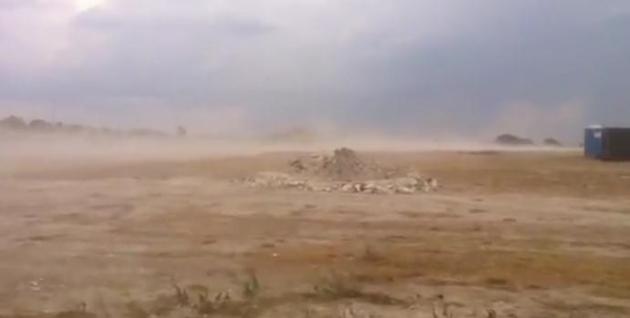
$4.1 billion. Estimated cost of the drought in Texas so far in 2011. That is $160 for every citizen in the state and $410 for every working adult. (photo: care2.com).
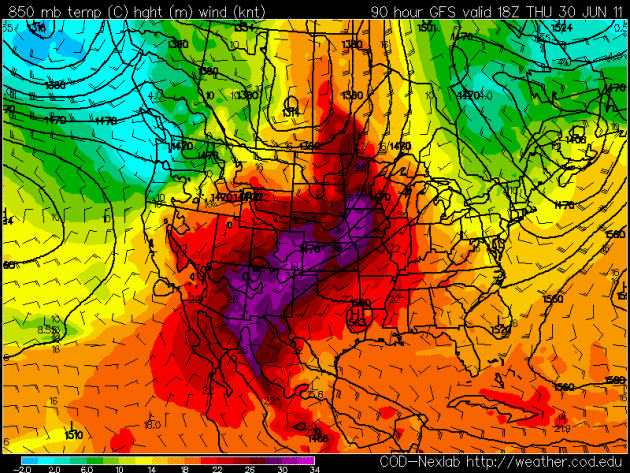
"...Nationally, 1,966 daily high maximum temperature records have been broken or tied so far this month (through July 23). Sixty-six of those records were all-time maximum temperature records.More impressive, however, are the figures for highest minimum temperature records. Because of the extremely high humidity levels during this heat wave, a whopping 4,376 record highest minimum temperature records were broken or tied through July 23. Of those minimum temperature records, 158 were all-time records." Capital Weather Gang, in an article below from Chris Mooney at desmogblog.com. (map above: College of Dupage weather center and NOAA).
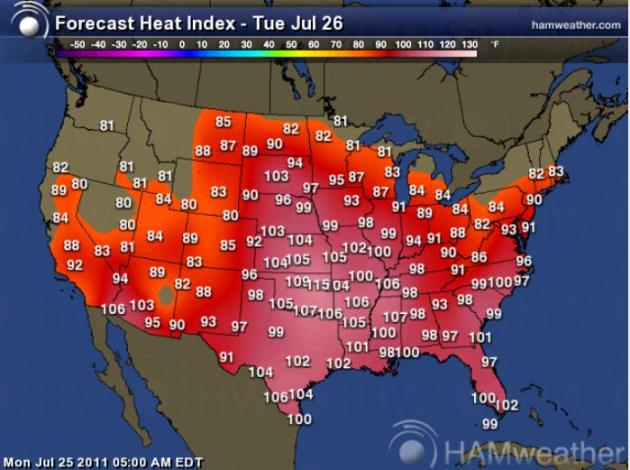
Tuesday Heat Index. Yes, it's "hot enough for me." Today should bring relief for much of New England and the Great Lakes. But factoring predicted high temperatures (and dew points) the dreaded heat index is forecast to top 100 from South Dakota southward to Texas, eastward to the Carolinas. Map courtesy of Ham Weather.
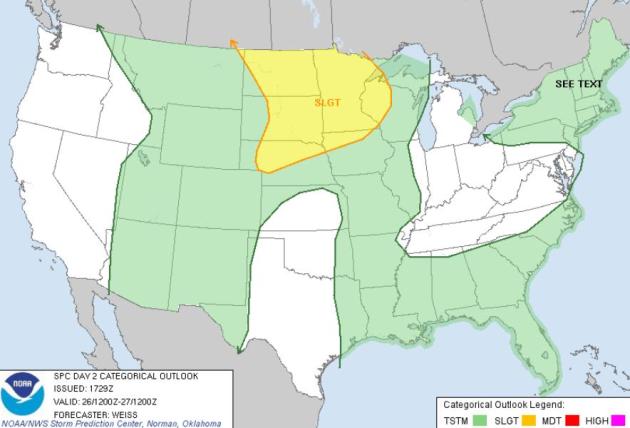
Tuesday Severe Threat. SPC is predicting a few waves of strong/severe storms popping up across the Dakotas, prevailing jet stream winds pushing those storms into Minnesota, western Wisconsin and northern Iowa.

Tuesday: Another Free Lawn-Watering. Strong to severe storms are likely from the Dakotas and Minnesota to the Front Range of Colorado, the "monsoon effect" sparking more storms across portions of Arizona, Utah and New Mexico. Texas remains dry (nothing new there), with heavy T-storms from New Orleans east to Mobile, Atlanta and Savannah. A "tropical wave" may dump out some 1-2"+ rainfall amounts on central and southern Georgia, while New England stays cool and damp with a few instability showers and sprinkles - nothing severe expected across the northeast. A shower may pop near Seattle, but most of the west should be sunny and dry.
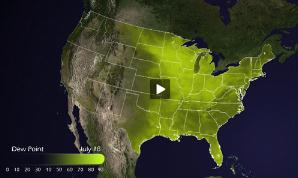
NOAA Satellites "Seeing" Humidity. This is a rather amazing time-lapse animation showing record-setting dew points sweeping across the USA, courtesy of satellite sensors onboard the GOES weather satellites, as well as low-orbit (POES) satellites 200 miles above the Earth. More from NOAA: "NOAA satellite imagery shows much of the United States is in the "red" this week, as a blistering heat wave tightens its grip and creeps eastward. High humidity is adding to the discomfort. NOAA’s two satellite systems — the Geostationary Operational Environmental Satellite (GOES) and the Polar-Orbiting Environmental Satellite (POES) — are helping forecasters predict the formation, movement and the eventual end of atmospheric conditions responsible for the scorching temperatures. Two GOES satellites, which hover in a fixed position more than 22,000 miles above the equator, are providing NOAA’s National Weather Service forecasters with constant images of the air, land and water of the Western Hemisphere. When it comes to tracking heat, GOES visible imagery identifies areas of cloud-free skies that helps speed the sun’s ability to heat the air and areas where clouds will slow down the heating process.

Heat Facts & Figures:
- 3,753 temp records were reported July 17-24, 2011. This makes up 56% of the total record temp reports for July 2011, so far. i.e...it's HOT!
- Today will be Dallas' 24th straight day of 100+ temps; Streak may last thru next week & beyond
- Raleigh, NC sets new consecutive +100 degrees record
- Sunday 7/24 marks the 5th day in a row above 100 degrees
- previous record stretch was 4 days set in 2008
- Sunday was 3rd day of 98+ in row @ PHL...record is 4 (set several times, last in August '01).
- DC's low has been 80+ for four straight days. From 1872-1930, there were 3 such days TOTAL.
- Central Park (New York City) has had 13 days over 90° and 2 over 100° this year.
- The top number of 90 degree days? 39, set in 1993 and 1991.
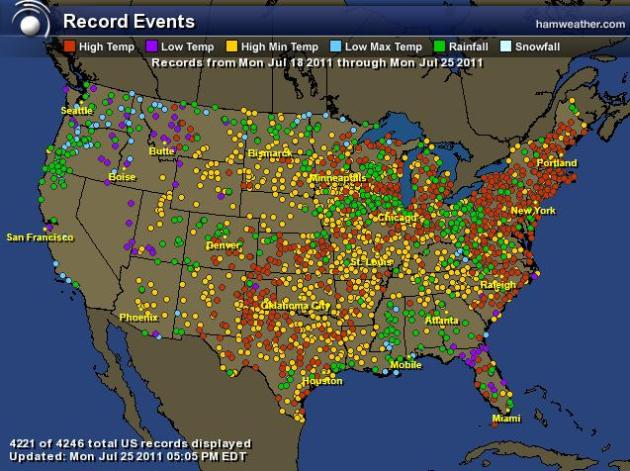
1 Week's Worth Of Records. An estimated 90% of the 4,246 records since Monday, July 18, were for record daytime or nightime heat (or new 24-hour rainfall records). Ham Weather has details here.
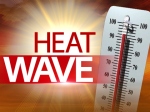
10 Heat-Related Deaths Reported In Philadelphia. Details:
- At least 10 heat-related deaths were reported during the weekend in the Philadelphia metro.
- Although officially last summer was the hottest ever in Philadelphia, the heat-related death toll for the entire season was just five. The 2011 city total now stands at 11, assuring this will be the deadliest season since 2008 when there were 26.
- It's true that July 2011 has gone toe-to-toe with the blistering heat of last July. So far, 17 of the first 25 days saw temperatures of 90 or better, one fewer than July 2010, and both Julys featured back-to-back days of 100-plus heat.
- However, the heat of last July was almost desert-like by comparison, with low humidities.
- In all likelihood, the Philadelphia death toll from last week's heat will increase.
- In higher mortality heat waves, it can take days for the medical examiner's office to locate to all the victims.
- Philadelphia's deadliest season was 1993's, with 118 heat-related deaths.
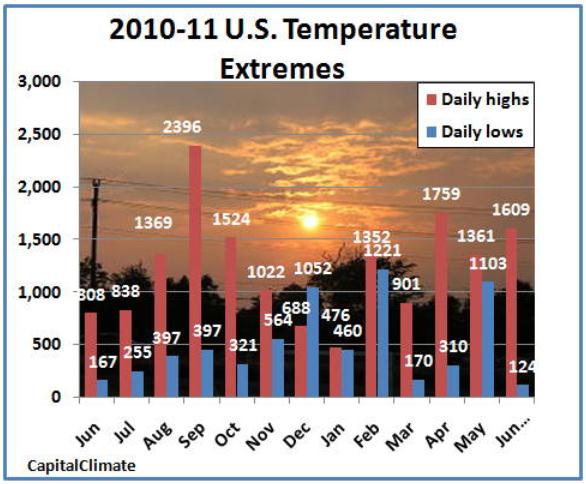
Summer 2011 Heat Records Crushing Cold Records By 13:1. Graphics courtesy of the Capital Weather Gang in Washington D.C. This weather "window" took data into account from June, 2010 through early June, 2011. Since then thousands of additional records have been broken, nationwide. The numbers tell the story - historic levels of heat (and humidity).

11,000+ Heat Records (And Counting). Data courtesy of CapitalClimate.

Turns Out, It's Neither The Heat Nor The Humidity. The Star Tribune's Bill McAuliffe takes a look at "dew point", and why it's a potentially superior way to measure how much water is really in the air, and how muggy it truly feels out there - compared with "relative humidity": "Ask people who don't like hot, humid weather, and they'll tell you that the weather measurement they rely on most is dew point. Not temperature. Not relative humidity. Dew point. "I think it's catching on," said meteorologist Paul Douglas. "It a superior way to, at a glance, determine what it really feels like out there." Dew point got a lot of attention during last week's heat wave, but it has been a common measurement for more than a century; it's been recorded at least daily in the Twin Cities since 1902. Last week, no daily high temperatures were broken, but the heat seemed extraordinary -- and dew points made the difference. Dew point is the temperature at which water vapor in the air condenses into liquid -- dew. But for human beings, the concept is more about sweat. As a person gets hot, the body sheds heat by generating sweat, which carries the heat away by evaporating. But when the air is humid, sweat has a harder time evaporating, because there's already a lot of water vapor in the air. Indeed, warm air can hold more vapor than cooler air, compounding the problem."
Too Much Water...
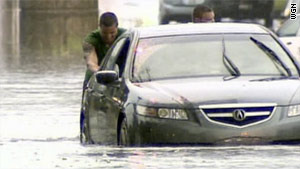
Last Saturday: Wettest Day In Chicago History. Chicago Weather Center meteorologists say, "Overnight rains that approached 7 inches over northern Cook County broke several impressive Chicago records. 6.91" of precipitation has been measured at O'Hare International Airport since Midnight making July 23rd Chicago's wettest calendar day in modern weather history". (photo courtesy of CNN, which has more on the severe flash flooding in Chicago last Saturday here).
Chicago's top 3 wettest calendar days:
Chicago's top 3 wettest calendar days:
1) 6.91" July 23, 2011
2) 6.64" September 13, 2008
3) 6.49" August 14, 1987
Not Nearly Enough Water...
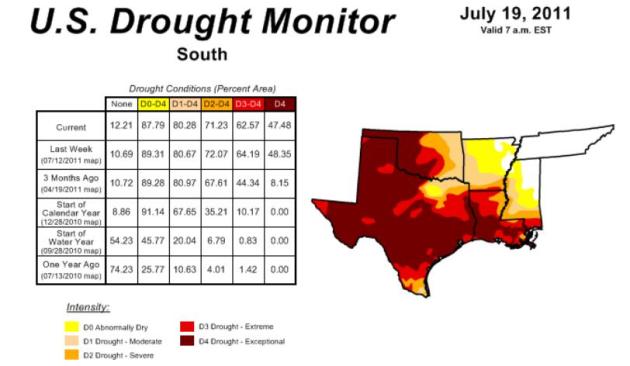
Cattle Herd Shrinks to Smallest Since 1973 as Drought Scorches U.S. South:
- Texas has officially experienced the driest nine-month period in the states history between October of 2010 and June 2011. This beat the previous record of June 1917 to February 1918.
- This is leading to widespread exceptional drought conditions -- which is nearing record levels (currently ranked as the 3rd worse in TX history).
- The worst of the drought is found in central and western Texas where precipitation deficits over the last 10 months exceed 20 inches in some areas. Midland and Lubbock have received less than 11 percent of their normal rainfall for the year so far.
- Drought is expected to worsen into August.
- Of course, the dry conditions are also leading to a record wildfire season. According to the Texas Forest Service, a record 3.3 million acres of land have been burned since mid-November by more than 15,000 wildfires.
- 47.48% of Texas is still in an "exceptional drought", according to NOAA's Drought Monitor (map above). Just 3 months ago only 8.15% of Texas was experiencing exceptional drought.
| City | Actual Precip. Since Jan. 1 | Normal Precip Since Jan. 1 | % of Normal |
| Houston | 9.34" | 26.55" | 35% |
| Austin | 7.95" | 18.87" | 42% |
| El Paso | 1.07" | 3.67" | 29% |
| Waco | 11.03" | 19.07" | 58% |
| San Antonio | 6.55" | 18.48" | 35% |
| Midland | 0.16" | 7.17" | 2% |
| Lubbock | 1.13" | 10.18" | 11% |
- 92% of Texas is under extreme drought
- 75% of the state qualifies as experiencing exceptional drought - roughly 3.5 times the size of Georgia
- If you add up all of the land area under some sort of #drought right now in the US, it is about the area of ALL of #Mexico!
- Rain is helping the drought in Georgia as only 9% of the state is under exceptional drought this week, down from 35% last week. However, 95% of the state is still under some form of drought.

- Florida is under NO exceptional drought, however 90% of the state is still under some form of drought.
- 97% of South Carolina under drought.
- 71% of North Carolina under drought.
- 61% of Alabama under drought.
- 70% of Mississippi under drought.

Heat Wave Likely To Continue Through Summer, Oklahoma Officials Say. An update from NewsOK.com: "If you think it's hot, wait until August. That's the message from state forecasters, who said no end to the heat wave is in sight as Oklahoma prepares to enter what is traditionally the hottest month of the year. Oklahoma City's high temperature hit 100 degrees Thursday, the 29th time it's been in triple digits this year. The record for most 100-degree days in a year is 50, set in 1980. Highs in the 100s are forecast through the next week. The sustained heat has taxed local water systems and claimed at least five lives, with another eight deaths possibly being caused by the heat, authorities said." (photo: MSNBC).
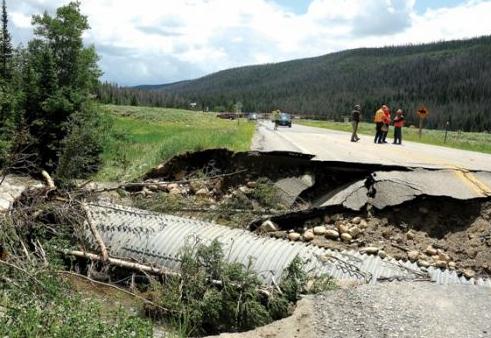
"Perfect Storm" Led To Deadly Flash Flood. The Colorado Springs Gazette.com has the story: "The rain dwindled around the Constantinides’ van around midnight Monday as the family packed up its soggy campsite and prepared to drive downstream. The most menacing clouds had passed an hour earlier. The campground they fled never flooded. And tragically, the biggest danger lay downstream. When the van plunged off a roadway that had washed out early Tuesday morning, the Colorado Springs family fell victim to a powerful weather phenomenon that evolved from a “perfect storm” over a small range of mountains in south-central Wyoming, according to the National Weather Service. Laurel Constantinides, 38, and her three daughters, Hannah, 8, Zoe, 5 and Lucia, 2, drowned as the van was swamped in Brush Creek. Alex Constantinides, 39, survived. Such flooding is a danger for much of the Front Range, as flash floods have the potential to hit arid areas such as Colorado Springs and, at times, miles from the worst storm cells."

After Floods, Debate Over Missouri River Rolls On. The New York Times takes a look at record flooding in 2011 along the Missouri River - the implications for transportation, how the U.S. has spent nearly $650 million reshaping the river to lower the flood potential and make it more "barge-friendly" "The record flooding this summer along the Missouri River has overwhelmed dams and levees, swamped small communities and forced large cities into emergency measures to hold the water back. And so the pressing matter of how to manage flooding on the Missouri has added a new urgency to the contentious question that has long nagged this region: What precisely is this river for? In a normal year, the water that is used to keep the river level high enough for barges comes from releases from the dam system built to control river flow. But the states north of the dams, including North and South Dakota, have argued that the river is no longer needed for navigation and that more water should be kept in the reservoirs for recreation, to help the region’s economy.....Once wide, shallow and unusually winding, the Missouri River has been drastically reshaped over the last century, at a cost of more than $650 million, to create a channel friendly to modern vessels, according to federal estimates. The result is a narrower, deeper, straighter river, which the government spends about $7 million a year to maintain."

E-Mails Show Corp Of Engineers Ignored Flood Warnings. The Great Plains Examiner has the serious allegation: "Federal water managers were warned repeatedly early this spring by hydrologists and local officials that the reservoirs along the Missouri River were too high and could lead to flooding, according to a series of e-mails released publicly last week. The e-mails were sent and received between Jan. 1 and May 30 by Jody Farhat, the U.S. Army Corps of Engineers’ top manager of the Missouri River reservoir system. The e-mails were turned over July 19 to satisfy Freedom of Information Act requests by the Great Plains Examiner, several other media outlets and a handful of politicians. Hundreds of e-mails were made public, providing a glimpse of the Corps of Engineers’ water management decisions during the months leading up to the flood. The records revealed a cavalier attitude by Corps’ water managers who became complacent about flood control after meeting early-spring targets and repeatedly dismissed concerns about flooding during the two months leading up to the flooding that displaced thousands of residents along a 1,700-mile stretch of the Missouri River. The Corps of Engineers evacuated water from the reservoirs in January and February to reach the pre-determined target levels of all three reservoirs along the upper basin of the river. But those “water-balancing” efforts ended in March, according to an e-mail sent by Farhat March 1."
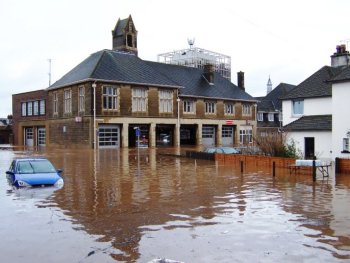
Flood-Prone Land Likely To Increase By 45% - A Major Challenge To Federal Insurance Program. The story from the New York Times (subscription may be required): "CHICAGO -- A three-year study to determine the possible impacts of climate change on federal flood insurance will warn of huge increases to the amount of land that could be inundated by rising sea levels, heavier downpours and stormier coastlines. The size of the nation's flood plains is expected to grow by 40 or 45 percent over the next 90 years, says the study, which is scheduled to be released later this summer. That prediction envisions waves of seawater pushing deeper inland during strengthening storms as oceans rise between 0.75 and 1.9 meters by the year 2100. In river valleys and other low-lying flow ways, more rainwater could routinely reach onto areas where current flooding is rare. Stretching the flood plains could encircle millions of new homes and businesses and expand the National Flood Insurance Program (NFIP) beyond its current volume of 5.6 million policies that protect property valued at $1.2 trillion from water damage. The study estimates that the program's policies could double in number by century's end." (photo: localwaterdamage.com).

Cleaning Up From A Flood: Some Practical Advice: North Dakota State University has some timely information about steps homeowners can take after a major flood, either river flooding or flash flooding: "NDSU Extension Engineer Ken Hellevang shares information on how to clean a flooded home. Here he narrates the PowerPoints in five sections and provides the PowerPoint slides as handouts."
* KSJB-AM Radio has more helpful information on flood clean-up and what's available at the NDSU web site: "Think of cleaning your home after a flood as a marathon, North Dakota State University Extension Service agricultural engineer and flood expert Ken Hellevang advises. Flood recovery is a long process, and it can have a huge impact on many parts of your life, including your health, emotions and finances. "Because cleaning a flooded home is such an enormous undertaking, don't make hasty decisions," Hellevang says. "This likely is a new experience for you, and you need to do the cleanup correctly. Be willing to seek help, not only for the actual cleanup, but also for issues such as dealing with stress and putting your financial life back together." He has developed five short videos on which he narrates PowerPoint presentations that provide tips for protecting yourself from hazards, assessing your home's structural integrity, cleaning flood-contaminated materials and drying the structure. The videos are available on NDSU's flood website at www.ag.ndsu.edu/flood. The PowerPoint slides also are available as handouts. NDSU's flood website also has many other resources to help with flood recovery, including money management, replacing lost documents, learning how to be resilient, dealing with your emotions, helping your children deal with stress, salvaging crops and restoring flooded farm equipment.

Floods Can't Dull Pioneer Spirit. Omaha.com has an update: "In the spirit of Lewis and Clark, scores of expedition enthusiasts and historians are proceeding on despite historic Missouri River flooding. About 170 members of the national Lewis and Clark Trail Heritage Foundation will gather in Omaha later this week for their annual meeting. The organization promotes the story of the 1804-1806 round-trip journey of the Corps of Discovery up the Missouri River and across the Rocky Mountains to the Pacific Ocean. The gathering Saturday through Aug. 3 will be a mix of scholarly lectures in Omaha and field trips in Nebraska, Iowa and South Dakota — where participants will walk in the steps of the Army expedition. The meeting will be the largest Lewis and Clark event in Omaha since Nebraska hosted one of the national commemorations that marked the expedition's bicentennial in 2004. Many activities are free and open to the public, including an encampment of expedition re-enactors in period costumes at Heartland of America Park, on the edge of the flooding river. There are fees, however, for bus tours and banquets."

Flood Rupture Pakistani Feudal Ties. AFB and Google have the story: "SUKKUR, Pakistan — Bakhsh Ali Lashari has spent the last year living in a tent since floods devastated a third of Pakistan. His home is no longer under water, but death threats mean he's never going back. The monsoon-triggered floods -- the worst in Pakistani history -- affected up to 21 million people, killed another 1,750 and ran up losses of $10 billion; a year later a shattered economy has barely recovered. Lashari's part of southern Pakistan was one of the worst hit areas, submerged in gushing waters that took months to recede. But the disaster gave him a chance to break free from centuries of oppression. He is one of thousands who prefer life in rotting camps to returning to feudal estates where debts and marriages can end in death. Lashari had a steady income as a labourer in Jacobabad, 375 kilometres (234 miles) north of Karachi, but said life became unbearable when an influential tribe took against one of their women marrying one of his relatives." (photo: digitaljournal.com).

Mennonite Group Works To Rebuild Homes And Spirits. Silicon Valley's Mercury News has the story: "LITITZ, Pa.—Rebuilding a community from the ruins of natural disasters requires more than hammers and strong arms. There's emotional damage, too, and those repairs can be the biggest challenge. That's one key lesson that members of the Mennonite Disaster Service have learned over 61 years responding to the devastation and heartbreak of earthquakes, floods, tornadoes and hurricanes. The group has a simple, hands-on mission—getting people back in their homes—but they know they'll do much more. "We see ourselves as facilitators," said Kevin King of Lititz, Pa., the group's executive director. Volunteers often show up ready with hammers or chain saws, only to find that the first thing people need is someone to talk to. MDS has sent teams in recent months to help rebuild towns in tornado-ravaged Alabama, Mississippi, and Joplin, Mo., as well as help flood victims in Minot, N.D. It has had crews working in Louisiana and on the Mississippi and Alabama coasts since Hurricane Katrina devastated the region in 2005."

New England Has Long History Of Battling Hurricanes. As we head into prime-time for hurricanes it's helpful to look back. 1938 was a devastating year for hurricanes across New England, the year the Big One came ashore, literally out of the blue, totally unpredicted. The Herald News in Massachusetts has a detailed analysis of what happened, and whether New England has learned from this mega-storm:
Caption above: "A hurricane in 1938 killed 588 people, and huge swells even had the power to lift ships and other large vessels and wreak havoc across the coast."
Story excerpt: "FALL RIVER — What tornadoes are to the Midwest and South, and what wildfires are to the West, hurricanes are to the East Coast — forces that come when they come and go when they will, leaving wreckage and death behind. Consider Hurricane Carol in 1954 and the words of The Herald News describing the aftermath. “Downtown Fall River resembled a bombed city," the paper said, “with tons of debris and fallen trees blocking the roads and sidewalks, shattered widows, twisted and broken church steeples, wrenched-off roofs, crushed or underwater automobiles and crippled power and telephone lines.”

Phoenix Is Hotter & Drier, A "New Normal" For The Valley. AZCentral.com has the story of the "new normals", the new, running 30 year averages, and what it means for the Phoenix metro area: "Early next week, Phoenix will turn hotter and drier than it was before. That's not a weather forecast or a gloomy new climate-change prediction. It's a matter of the record books. On Aug. 1, the National Weather Service will turn the page in its book and begin using new numbers to describe normal weather conditions - the high and low temperatures, rainfall - in Phoenix and cities across the nation. Normal weather is based on the average of a 30-year period. The averages are updated every 10 years by climatologists at the Weather Service's parent agency. For the past 10 years, the average has been based on records for 1971-2000. Starting Aug. 1, records for the 1970s will drop out of the average and those from 2001 through 2010 will be added, creating a new 30-year time frame. The new average will show what many Valley residents have felt: Although Phoenix has always been hot, it's a little hotter. The days get hotter earlier in the year and stay hotter longer, and the nights have grown warmer every month of the year." (photo courtesy of city-data.com).
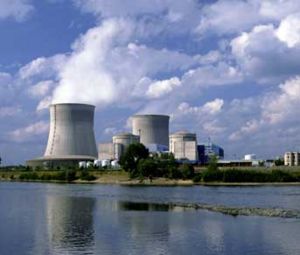
Heatwaves Putting Pressure On Nuclear Power's Outmoded Cooling Technologies. Reuters has the story: "The scramble to cool the Fukushima Daiichi nuclear complex with seawater in the aftermath of Japan's disastrous accident put a spotlight on just how much cold water an atomic reactor needs to function — and not just in a crisis. All existing nuclear plants use vast amounts of water as a coolant. But in recent years — often far from the public eye — hot river and lake temperatures have forced power plants worldwide to decrease generating capacity. Experts say the problem is only getting worse as climate change triggers prolonged heat waves, prompting calls for changes in siting processes." (photo courtesy of wikinvest.com).
"Weathercasters, start your engines! Mark Kriski of KTLA and Dallas Raines of KABC — both veteran weathercasters in the Los Angeles market — will go head-to-head Saturday night in a stock car race held at the Toyota Speedway in Irwindale, CA. Raines and Kriski are two of the competitors in the Toyota Kids Against Cancer Celebrity Benefit stock car race, which will be held tomorrow night. They will drive identical S-2 NASCAR stock cars and compete against other celebrities, including Frankie Muniz and Kim Coates."


Your Very Own Portable, Tropical Island Paradise. Who said that conspicuous consumption was dead? For people with more money than sense, check out this "portable tropical island" concept, a mega-boat that doubles as your own private island (coconuts not included). Gizmag.com has the details: "Owning one's own yacht must surely be one of man's greatest indulgences. The ability to take your own tailored environment anywhere you want. Yacht Island Design creates tailored environment like no other. Following on from its "Streets of Monaco" design is the "Tropical Island Paradise", a 90 metre island with a top speed of 15 knots."

Foldable Boat Packs Into A Portable Carry Bag. Gizmag.com has another eye-opening story: a boat you can carry with you, in a backpack. What will they think of next? "Joining the list of foldable products, Foldaboat is a flat-pack recreational boat suitable for flat water environments like canals and lakes. Designed by Arno Mathies & Max Frommeld, the 2.5-meter (8.2-foot) boat is made from a solitary piece of plastic, and after a few simple folds it packs nicely into a 150 x 60 cm (59 x 24 inch) parcel.....Foldaboat was the product of a paper-folding workshop that focused on creating 3D objects from 2D drawings. The project has yet to make to the manufacturing stage, but we think it would be great for water lovers, campers and potentially as an emergency item for residents living in flood zones."


A Summer To Remember
"How's the weather?" Well, how much time do you have? 108 at Newark, 105 at Dulles (DC area) last weekend - both temperatures the hottest ever recorded. 3,753 temperature records just last week. Record highs outnumbering record lows by 14:1 since 2010.
More coincidences, right?
America's weather has become "super-sized". Dallas: 25 days/row above 100. Nearly 7" rain soaked Chicago Saturday, the wettest day in Windy City history. Floods north, epic drought conditions south. Nearly half of Texas is enduring a withering drought; the 3rd worst in history. It may take a hurricane or tropical storm to dig out from a massive rainfall deficit. Farmers have given up; estimated damage so far over $4 billion.
Climate Stories...
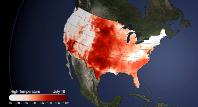
Forget Tornadoes. Let's Talk - Unendingly - About Heat Waves And Global Warming. Here's an excerpt of an important post from Chris Mooney at desmogblog.com: "Earlier this year, I grew uncomfortable with attempts to link the massive tornado destruction that we saw in the U.S. to climate change. As I explained then—based on an interview with Harold Brooks, one of our top experts on tornadoes and climate—the evidence just doesn’t support this assertion. We can’t show that tornadoes have gone up, or gotten worse. Nor can we show that the theory or models predict that they should in a warming world. However, we’ve just experienced a staggering U.S. heat wave (visual here), and that makes it seriously time to talk about the link to climate change, and not shut up any time soon....What this means is that now—not during the May peak of tornado season—is the time to once again try to rally the public to care about climate change. The seasonality of public concern is annoying, or even downright irrational, but it’s also very real. Just look at the public opinion data from Yale and George Mason: When people are asked either about whether “The record heat waves last summer in the United States strengthened my belief that global warming is occurring” or whether “The record snowstorms this winter in the eastern United States make me question whether global warming is occurring,” their answer is, basically, “Yes.” Actually, to be precise, 54 percent somewhat or strongly agree with the former, while 47 percent somewhat or strongly agree with the latter—and they’re surely not all the same people. Still, this just hints at the pliability of public opinion on this issue when the weather changes."
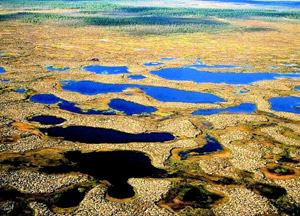
Climate Change "Remobilizes" Long-Buried Pollutants As Arctic Ice Melts. The story from the New York Times: "Warming in the Arctic is causing the release of toxic chemicals long trapped in the region's snow, ice, ocean and soil, according to a new study. Researchers from Canada, China and Norway say their work provides the first evidence that some persistent organic pollutants (POPs) are being "remobilized" into the Arctic atmosphere. "Our results indicate that a wide range of POPs have been remobilized into the Arctic atmosphere over the past two decades as a result of climate change, confirming that Arctic warming could undermine global efforts to reduce environmental and human exposure to these toxic chemicals," write the scientists, whose analysis was published yesterday in the journal Nature Climate Change. That's of concern because POPs can travel long distances on air currents, persist in food and water supplies, and accumulate in the body fat of humans and other animals. The pollutants also can be passed from mother to fetus and have been linked to serious health problems in humans and other animals." (photo courtesy of sott.net).

Global Warming's Toxic Side-Effect. Here's another story dealing with the pollutants being released in the Arctic, this one from Australia's climatespectator.com: "Here's a scary new word for the climate change lexicon: revolatilisation. According to scientists, this is what happens when deposits of persistent organic pollutants (POPs), a group of banned toxic chemicals that are highly resistant to biodegradation that have accumulated in regions like the Arctic – stored in sinks of soil, water and ice – are released back into the atmosphere through the melting of the ice. It's yet another projected impact of global warming, according to new scientific research published online this week in Nature Climate Change. And according to the researchers, there's evidence the process may have already begun. The research shows that many POPs – which have been shown to accumulate in the fatty tissues of humans and wildlife and can cause cancers and birth defects, thus causing them to be banned under the 2004 Stockholm convention – are being remobilised into the atmosphere from repositories in the Arctic region as a result of sea-ice retreat and rising temperatures, which is exposing more water to the sun. Say the researchers (a team of four from Canada, China and Norway): "We analysed records of the concentrations of POPs in Arctic air since the early 1990s and compared the results with model simulations of the effect of climate change on their atmospheric abundances. Our results indicate that a wide range of POPs have been remobilised into the Arctic atmosphere over the past two decades as a result of climate change, confirming that Arctic warming could undermine global efforts to reduce environmental and human exposure to these toxic chemicals." (photo courtesy of futureisnow.com).
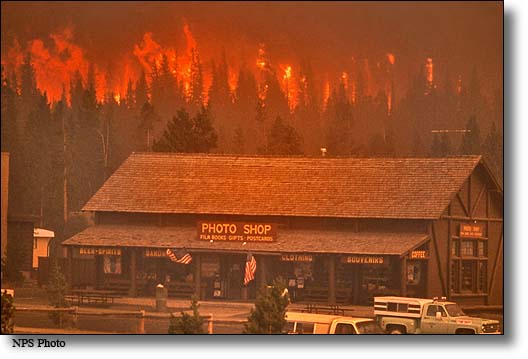
Global Warming To Flame Wildfires At Yellowstone: Study. A report in the International Business Times: "Global warming will cause more wildfires at Yellowstone National Park. The combination of the wildfires and rising temperature will fundamentally change the ecosystem at Yellowstone, possibly by as soon as 2050, according to a new study led by Professor Anthony Westerling of the University of California, Merced. The study claims that by 2050, wildfires will burn up 400 square miles of land per year. By 2075, it's expected to burn up 1,200 square miles per year. The entire area of Yellowstone National Park is under 3,500 square miles. Furthermore, the study claims "years with no large fires - very common in the recent past - become extremely rare by 2050 and are all but eliminated after 2050. Global warming and its effects on the entire ecosystem of Yellowstone, not just on plant life, are expected to be significant. Dense forests are expected to give away to more open woodland, grass, and shrub vegetation. Forests will become younger on average (because trees will be frequently killed by fires). Moreover, entire populations of trees are expected to disappear." (photo courtesy of the National Park Service).


Earth Talk: Modern Agriculture's Enormous Environmental Footprint. Kansas City's Infozine.com takes a look at the carbon-intensive agricultural business: "What amazes many environmental advocates to this day is how the widespread adoption of synthetic chemical pesticides, herbicides and fertilizers for use in agriculture was dubbed the “Green Revolution,” when in fact this post-World War II paradigm shift in the way we produce food has wreaked untold havoc on the environment, food quality and human health. Agricultural output has certainly increased as a result of these changes, but with the vast majority of the world’s farms now relying on petroleum-derived synthetic chemicals to grow crops and petroleum-derived fuels to drive the engines of production—modern agriculture has become overwhelmingly toxic to the atmosphere and is hastening global warming. The Intergovernmental Panel on Climate Change (IPCC) reports that agricultural land use contributes 12 percent of global greenhouse gas emissions; here in the U.S. almost 20 percent of our carbon dioxide emissions come from agricultural sources."
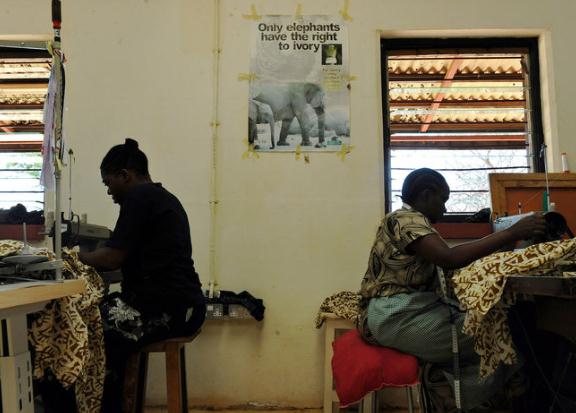
A Slow Start For The Carbon Credit Market. Details from the New York Times: "WASHINGTON — As U.N. talks keep failing to agree how to raise money to protect forests, private investors are testing a trade in credits to slow the deforestation that emits as much carbon as all the world’s cars, ships, trucks and planes.....So far, the only demand for forest carbon credits has been in the voluntary carbon market, worth $424 million last year, which lacks the binding rules of the Clean Development Mechanism. Governments like those of Norway, Germany, Britain and the United States have pledged $6.5 billion to help poorer countries develop systems to reduce emissions from deforestation, but that is seen as only a halfway measure. Private-sector involvement will be essential. Recent studies suggest that between $17 billion and $33 billion per year is needed to achieve a U.N. Environment Program recommendation to halve global emissions from deforestation by 2030. “We are not going to get the scale of what we need without participation by the private sector,” said Donna Lee, who was the lead U.N. negotiator on REDD for the United States and is now a consultant for the advisory group Climate Focus."

Why Not Ban Products Responsible For Global Warming? Boston.com has a thought-provoking Op-Ed: "BEHIND HIS protest against the banning of incandescent light bulbs (“How many lawmakers does it take to . . .,’’ July 17, Op-ed), Jeff Jacoby raises an issue worthy our attention: Should our lawmakers be able to ban products that contribute to global warming? What measures can our country appropriately take to move our economy toward care for the earth’s future? In a bad economy we’re all concerned about our immediate future. Fair enough. But any of us who have children and grandchildren should be concerned about more than how they’re going to pay our debts if we don’t pay them. What about the hot, stormy world that science tells us they will have to live in if we insist that “consumer choice’’ is more important than reducing carbon pollution?
Let’s be grateful that our government has taken this small step, and encourage it to take greater ones."
Isabel Best
Belmont
Belmont

A Primer For Climate Change. Southern Fried Science has the review and story of a new book taking a frank look at climate change, the science and an entire industry devoted to denial: "Two chapters are entirely dedicated to the manufacture of doubt. These two chapters really shine as new and important contributions to the climate change literature. Climategate, the leaking of several thousand e-mails which, though it revealed absolutely nothing, became a lightning rod for the denialist industry (and I do mean industry, as they painstakingly lay out the funding sources and motives behind the major political and corporate players who are manufacturing climate change dissent). To paraphrase Senator Inhofe, the myth that human activities haven’t led to measurable and significant changes to the natural systems governing the earth’s climate is the real “greatest hoax ever perpetrated on the American people.” But Pilkey and Pilkey don’t just pick on the low hanging fruits of climate change deniers. They also address some of the misconceptions that have promulgated through the climate change community, explain some of the issues with mathematical models, and discuss the detrimental results of “bandwagon” and “state-of-siege” effects. These chapters could best be summed up with a quote from Elizabeth Kolbert:
“No one has ever offered a plausible account of why thousands of scientists at hundreds of universities in dozens of countries would bother to engineer a climate hoax."
